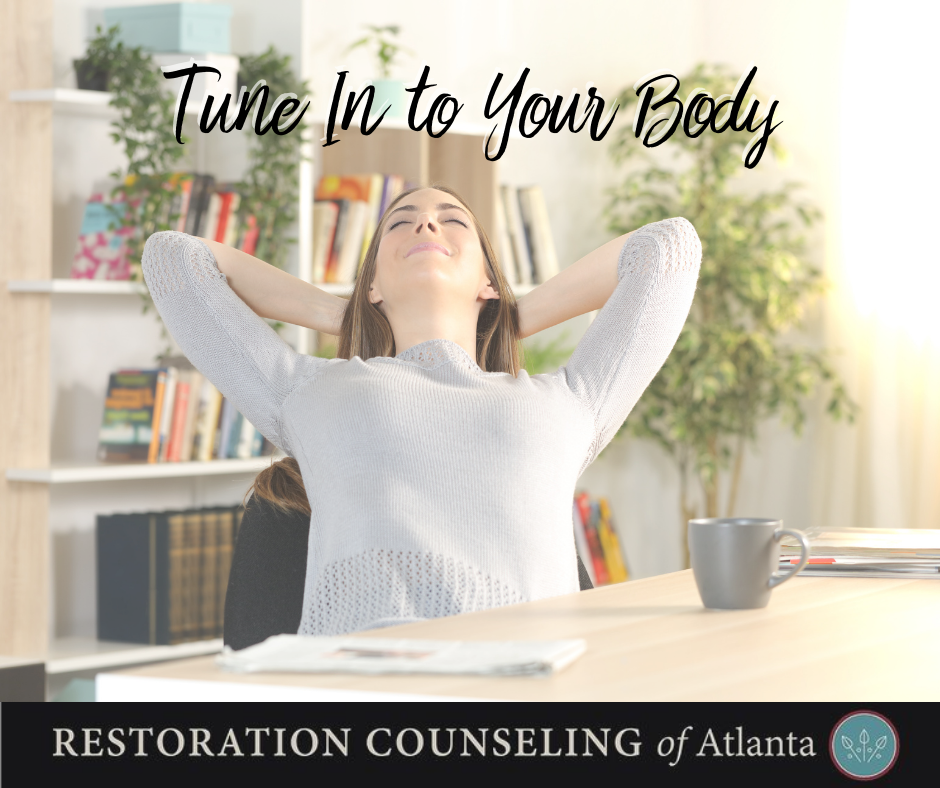I love podcasts. They are one of my favorite ways to listen to content while juggling the mom life. I recently discovered a new podcast called “Being Known” with Curt Thompson, and I highly recommend it! These 30 – 60 minute episodes are filled with playful banter between two close friends, an actor/producer (Pepper Sweeny) and a psychiatrist (Dr. Curt Thompson) who identifies as an interpersonal neurobiologist. They seamlessly weave brain science, relationships, and the gospel in an honest and accessible way. Listening to these may help as you learn how to tune into your body.
In a recent episode (episode 7, in case you want to listen), Curt and Pepper talked about emotions. In their conversation, Dr. Thompson said something that I knew instinctively but had never heard it said that way before.
Three Takeaways to Share
1. Emotions are always here. We often think of having an emotional moment as if emotions are something we can opt in or out of, or as a separate compartment, or something to be managed. Dr. Thompson points out that emotions are always present in the system, and the real question is whether we can notice, identify, name, and regulate them.
2. There are primary and secondary emotions. This is not what I previously thought. I was trained that primary emotions were the eight or so universal emotions like mad, sad, happy, frustrated, etc. The secondary emotions were considered more complex, akin to secondary colors on a color wheel.
Dr. Thompson defines primary emotions as emotions that hit our bodies, and that we may not even be aware of what is happening. He describes these primary emotions as things like chest tightness, discomfort, and body sensations. According to Dr. Thompson, secondary emotions would be our reactions and responses to this primary emotional energy. What we sense would be primary. How we make sense of it, what we name it, or how we respond to it would be secondary.
3. Regulate, regulate, regulate. If we accept that humans have emotions that come whether we like it or not, then a healthy way to be a human with emotions is to learn to calibrate or regulate those emotions. Dr. Thompson suggests that we grow emotionally when we learn how to move toward emotions with curiosity, learn from them, and have a community that we invite to speak into our lives and restore truth and balance.
Dr. Thompson spent much more time on each of those points. However, I want to give you three areas to start practicing. In this article, I want to help you learn to collect primary emotional data and how to tune into your body more effectively so that you can self-regulate.
A Visualization Exercise
Let’s start checking into your body with this visualization exercise. This exercise is a good practice to tune into your body or notice your body and to help manage primary emotions of physical tension, tightness, and discomfort in your body.
Ask yourself these questions:
Close your eyes and see if you notice any tightness, discomfort, or unusual sensation that you may be holding in your body. As you notice these feelings in your body, I want to invite you to start visualizing the tension, discomfort, and unusual body sensations. Where are they located on your body?
Ask yourself these questions:
- If the body sensation, tightness, or discomfort had a shape, what shape would it be?
- What color would the shape be if it had a color?
- If it had a texture, what texture would it be?
- If the shape had a temperature, what temperature would it be?
- Can you visualize that shape?
Now, what color do you associate with healing, movement, or perhaps the work of the Holy Spirit? Hold that color in your mind.
Now imagine a powerful light coming from the ceiling in that healing color. This light is never-ending, and you can use it as much as you would like. Visualize the light as if it was pouring down like a beam of healing balm, a never-ending source of power. Just notice what happens to the shape when the healing color comes in contact with it. Allow the light to continue to impact the shape and notice what happens without trying to force change. Just notice what you are experiencing.
What do you notice as you tune into your body now? Any change in your body sensations? Do you notice any change, movement, or shift? Is it difficult for you to focus on your body and listen to its cues? All of this is good information.
What if you are unaware of your body cues?
Maybe this visualization is too out of the box for you, or you want to start with something a bit simpler. Great! Start by gently increasing your body awareness by engaging in a simple practice of checking in with your body. Challenge yourself to begin noticing what is happening in your body when you are calm and happy. Notice your breath, your heartbeat, or whatever it is that lets you know you are calm and happy. These are valuable clues.
When you have a calm baseline, begin paying attention to your body’s responses to stressful or challenging moments. Look for changes in your breath, what happens to your heartbeat, any tightness or tingling. The more you learn to listen to your body’s cues, the better you can manage daily emotions by returning to calm.
As you learn how to gather information and tune in to your body, the information will typically fall into three different categories.
Three Categories of Body Responses
- Over/ HYPERarousal – think a shot of adrenaline, fast heart rate, shallow breath, panicky feeling, fast thoughts, out of control, overloaded system, autopilot, fight or flight.
- Under/HYPOarousal – zapped of energy, your body wants to shut down, spaced out, zoning out, numb, frozen. Again, these are not reactions that we consciously choose, they are automatic, and they take over.
- Within your capacity or window of tolerance – you feel like you can manage the current stressors. Life doesn’t have to be perfect, but you can deal with what you have going on.
Keep in mind that these are not reactions that we consciously choose. They are automatic, and they take over. Instead of telling yourself to try harder or push through, help your body and system return to your window. That is the practice of regulation.
Tools You Can Use
Here are some tools for regulating Hyper and Hypo states of arousal. These sample activities are not one size fits all. It is important to find what works for you and know which tools and activities are helpful.
Hyper- Ideas of activities to decrease arousal:
- Mindful breathing (deep and slow diaphragmatic breathing)
- Grounding (counting objects, pushing your feet on the ground)
- Physical exercise or labor (pushups, jumping jacks, sprints, stairs, weights, intense yard or housework
- Using a weighted blanket
- Shaking or stomping out excess energy
- Soothing and calming music
- Comforting food
- Go on a walk. Bonus if you can call a safe friend or loved one or take a pet with you.
Hypo- Ideas of activities to increase arousal:
- Smelling essential oils or thinking of your favorite smells
- Gentle movement (yoga, stretches)
- Grounding (counting objects, pushing your feet on the ground)
- Mindful breathing (deep and slow diaphragmatic breathing)
- Soothing and calming music
- Play with a pet
- Go outside and walk barefoot on the ground.
I hope that you become more aware of how important it is to tune into your body and learn to listen to your first cues of not being well. As a result, you can more effectively regulate your body, mind, and emotions.

Written by:
Rebeca Gilbert

